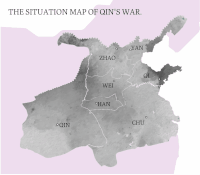
Back حروب تشين للتوحيد Arabic Guerres d'unificació de Qin Catalan شەڕەکانی یەکخستنەوەی چین CKB Guerras de unificación chinas Spanish جنگهای یکپارچگی چین Persian Guerres d'unification de Qin French Perang penyatuan Qin ID Guerre di unificazione dello stato di Qin Italian 秦の統一戦争 Japanese Guerras de unificação da China Portuguese
| Qin's wars of unification | |||||||||
|---|---|---|---|---|---|---|---|---|---|
| Part of the Warring States period | |||||||||
 Date of conquest of the six states | |||||||||
| |||||||||
| Belligerents | |||||||||
| Qin | |||||||||
| Commanders and leaders | |||||||||
| Strength | |||||||||
| 1,200,000[citation needed] | 1,500,000[citation needed] | ||||||||
Qin's wars of unification were a series of military campaigns launched in the late third century BC by the state of Qin against the other six states remaining in China – Han, Zhao, Yan, Wei, Chu and Qi. Between 247 and 221 BC, Qin had developed into the most powerful of China's Seven Warring States that coalesced in the wake of the declining Zhou dynasty, which had been reduced to a weak and merely ceremonial position during the Warring States period. In 230 BC, Ying Zheng, the King of Qin, began the sequence of campaigns that would bring the Warring States period to a close, setting out to conquer each of the six states one by one. This was completed in 221 BC with the fall of Qi, which further led to a more centralised form of government replacing the fengjian system of the Zhou dynasty. Ying Zheng declared himself the First Emperor – or Shi Huangdi – of a unified China under the Qin dynasty.